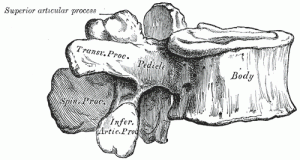Lumbar vertebrae carry the greatest amount of body weight and are thus characterized by the large size and thickness of the vertebral body. They have short transverse processes and a short, blunt spinous process that projects posteriorly. The articular processes are large, with the superior process facing backward and the inferior facing forward.
Detailed features
The body is large, wider from side to side than from before backward, and a little thicker in front than behind. It is flattened or slightly concave above and below, concave behind, and deeply constricted in front and at the sides.
The pedicles are very strong, directed backward from the upper part of the body; consequently, the inferior vertebral notches are of considerable depth.
The laminae are broad, short, and strong; the vertebral foramen is triangular, larger than in the thoracic, but smaller than in the cervical region.
The spinous process is thick, broad, and somewhat quadrilateral; it projects backward and ends in a rough, uneven border, thickest below where it is occasionally notched.
The superior and inferior articular processes are well-defined, projecting respectively upward and downward from the junctions of pedicles and laminae. The facets on the superior processes are concave, and look backward and medialward; those on the inferior are convex, and are directed forward and lateralward. The former are wider apart than the latter, since in the articulated column the inferior articular processes are embraced by the superior processes of the subjacent vertebra.
The transverse processes are long, slender, and horizontal in the upper three lumbar vertebrae; they incline a little upward in the lower two. In the upper three vertebrae they arise from the junctions of the pedicles and laminae, but in the lower two they are set farther forward and spring from the pedicles and posterior parts of the bodies. They are situated in front of the articular processes instead of behind them as in the thoracic vertebrae, and are homologous with the ribs. Of the three tubercles noticed in connection with the transverse processes of the lower thoracic vertebrae, the superior one is connected in the lumbar region with the back part of the superior articular process, and is named the mammillary process; the inferior is situated at the back part of the base of the transverse process, and is called the accessory process (Picture 2).

